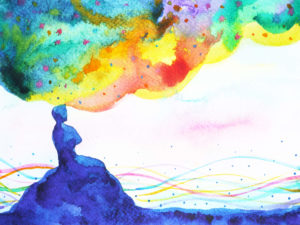What is visual journaling?
Visual journaling [also called art or drawing journaling]It has been recognized as a valuable and accessible approach to expressive arts therapy, counseling, education, and education. It is not only an effective method for stress reduction, but also is considered a creative way to express personal narratives and life stories as well as make meaning through images, creative writing, and story sharing.
Why combine images and words?
Pizarro (2004) found that art therapy and writing combined had more positive effects on stress perception than writing alone.
Visual journaling: History
Through history, visual records of thoughts have been kept. Pictographs (rock painting) and petroglyphs (rock carvings), are the oldest forms symbol language that represent complex cultural meanings, often layered over time. Japanese 10Th century “pillow books” were private written and visual journals (collection) depicting personal thoughts, feelings, and reflections about court life (Kasahara, 2017). Lakota Winter Counts is another example of indigenous methods of recording historical events: A storyteller creates a pictograph (snowfall to winterfall) on hide and cloth.Atka Lakota Museum & Cultural Center, n.d.).
Benefits of visual journaling
Visual journaling and artmaking have many health benefits. For instance, engaging in brief artmaking has been shown to enhance immunity and decrease cortisol levels (Lorance & Warson, 2012; Hayes et al., unpublished raw data). Many of these benefits can be attributed to visual journaling, but research on the specific effects of visual journalsing revealed a decrease of anxiety and negative affect (Mercer et. al., 2010).
A 2012 study with southeastern tribal elders showed that visual journaling was sustained for two months with a 95% response among 26 participants (Warson (2012). Preliminary data analysis showed a preference for drawing everyday life events, such as picking up peas from the garden or designing quilt patterns, and also references to family and spirituality. These preliminary findings indicate that mindfulness-based awareness was evident through the re-experiencing and re-examination of important daily tasks. Visual journaling is proving to be a promising intervention in stress reduction.
Guidelines for visual journaling
To maximize your benefits, pick a time each day to work in your journal. A small bag with your favorite art supplies and a small case for travel is a good idea. Five minutes of sustained visual journaling can lead to health benefits like increased dopamine or serotonin levels (Zaidel 2014).
Research on visual journaling shows that a self-directed approach to visual journaling is just as effective as using prompts (Mercer et. al., 2010). Your own approach is possible, and you can change it as your awareness grows. Visual journaling can be used to generate new themes over time. Mindfulness-based practices can also be a good fit for visual journaling.
Suggested visual journaling exercises
- Write one word to describe how you feel right now.
- Make a symbol for your day and write one sentence to describe it.
- Draw or trace a circle if you’re having a bad day. Use lines, shapes, colors, and color to create a symbol for your feeling in the circle. Write down words to describe this feeling. If you wish, you can print this drawing from your journal.
- Draw a picture of your favorite place. This place can be shared with someone.
- Make a symbol of tension. Write down a word that describes this state. Start at your feet and work your way up to the top of each muscle. Then, let go. Continue this until you reach your top.
- Write down a word to describe the state of relaxation by creating a symbol.
- A circle of wellness can be created. Draw or trace your circle. Divide it into four sections using symbols that represent physical, emotional and spiritual activities. You can label each activity and share your circle of wellness with someone.
- Make a circle of friends and family. Draw or trace the circle. Paste photos (or magazine images), of family and friends who have been a support. Include a photo of yourself. You can also share stories about each other.
- Have fun with your own approach.
Refer to
Atka Lakota Museum & Cultural Center, (n.d.). Lakota winter count. http://aktalakota.stjo.org/site/News2?page=NewsArticle&id=8993
Mercer, P., Warson, E., & Zao, J. (2010). Visual journaling: A way to reduce stress, anxiety, or affect medical students. The Arts in Psychotherapy, 37(2), 143-148.
Kasahara, Z. (2017, Feb. 2). The pillow book. https://zelda-kasahara.medium.com/most-japanese-people-can-recite-the-famous-opening-lines-of-the-pillow-book-by-sei-shonagon-b205552e01ee
Pizarro, J. (2004). Art and writing therapy’s efficacy: Enhancing mental health outcomes and participant retention. Art Therapy: Journal of the American Art Therapy Association. 21(1), 5–12.
Warson, E. & Lorance, J. (2012). (2012).. C. Malchiodi. (Ed.), Art Therapy and Health Care. New York, NY: Guilford.
Warson, E. (2012). Healing across cultures: Healing arts in healthcare with American Indians and Alaska Native cancer survivors C. Malchiodi. (Ed.), Art Therapy and Health Care. New York, NY: Guilford.
Zaidel, D. W. (2014). The biological and neurological aspects of creativity, brain, art, and imagination. Frontiers in human neuroscience, 8, 389. https://doi.org/10.3389/fnhum.2014.00389
© Copyright 2022 GoodTherapy.org. All rights reserved.
The author of the article mentioned above wrote the content. GoodTherapy.org is not responsible for the opinions and views expressed. Questions or concerns about the article can be directed at the author or left as a comment below.



Good day! I could have sworn I’ve been to this site before but after checking through some of the post I realized it’s new to me.
Nonetheless, I’m definitely happy I found
it and I’ll be bookmarking and checking back often!